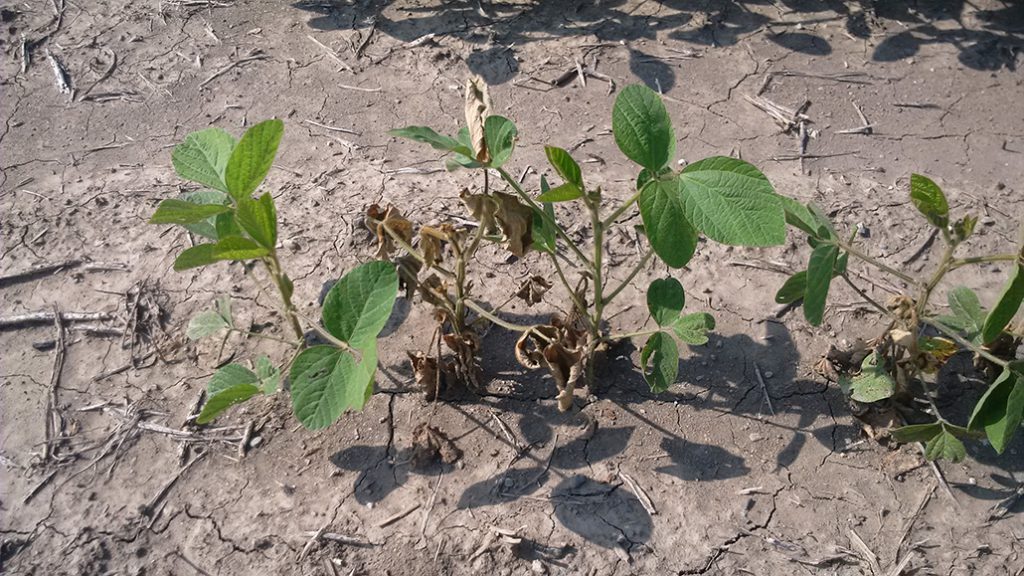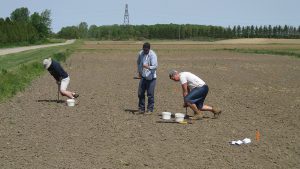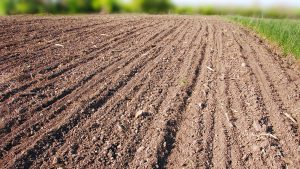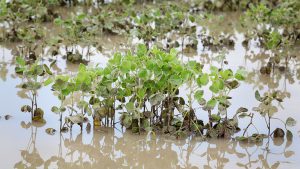Fighting phytophthora
NEW GENE DISCOVERY BY AAFC SCIENTIST

PHYTOPHTHORA SOJAE (P. SOJAE) isn’t a new nemesis to soybean farmers. Every year, the root and stem rot disease results in significant damage around the world, forcing farmers to replant or face costly crop losses. The disease already exists in most Ontario fields, and challenging growing conditions increase the problem — the disease, like others, thrives in cool, wet weather — enabling this disease to devastate crops during already difficult times.
In order to mitigate risks, growers rely on integrated pest management systems that combine appropriate genetics, chemical treatments, and management practices. Growers have found varying success with these systems — crop losses cannot be completely eliminated, but can be significantly reduced with its implementation. Common practices to control P. sojae include soil treatment with calcium application, fungicide application, and improved soil drainage and tillage, however, in addition to being relatively ineffective, these methods have been found to lead to resistance.
With soy crops in Canada, and internationally, increasing in acreage annually, it’s becoming increasingly important to find solutions to diseases that can carry such productive and financial consequences.
“Phytophthora stem and root rot is one of the most destructive soybean diseases found in Canada and worldwide,” says Dr. Sangeeta Dhaubhadel, researcher, Agriculture and Agri-Food Canada (AAFC).
REDUCING LOSS
According to AAFC, P. sojae causes approximately $50 million of soybean yield loss in Canada and global losses between $1 and $2 billion annually.
“Many strategies have been developed to combat the disease, however, these methods have proven ineffective in the long term. A more cost effective and durable approach is to select a trait naturally found in soybeans that can increase resistance,” says Dhaubhadel.
Phytophthora stem and root rot disease is mainly managed through breeding for resistance, which can be achieved through single or multiple gene resistance. Single gene resistance is an effective control measure that provides complete resistance if growers know which races of pathogen are present in their soybean field. However, pathogen changes over time make the resistant cultivar susceptible to P. sojae. Quantitative or partial resistance is governed by multiple genes, each with minor effects. Quantitative resistance is more durable, able to provide protection against diverse races of pathogens, and is not easily broken over time.
To aid in resistance against P. sojae, soybeans produce the isoflavonoid glyceollin which confers partial resistance against disease. Identifying the key genes involved in the synthesis of glyceollin in soybean will help in breeding resistant cultivars.
And that’s what Dhaubhadel’s research has done.
Dhaubhadel and her team isolated 11 CHR genes in soybeans which function in a critical step in the fight against Phytophthora, including the genes involved in creating glyceollin, which will be key to breeding new disease-resistant varieties of soybeans. Previously, only two genes had been identified, resulting in fewer opportunities for built-in resistance to new varieties.
“This is the first robust study on identifying CHR genes in soybean which are key to creating varieties resistant to P. sojae. A previous study identified only two CHR genes. This research is good news for soybean farmers as they can expect to have soybean cultivars that are more resistant to P. sojae.”
IDENTIFYING GENES
According to an AAFC press release announcing the research’s findings, the recent study is the largest and most comprehensive of its kind in identifying soybean CHR genes. It found a naturally occurring trait in soybean that improves resistance — the rapid, increased production of isoflavonoid glyceollins. Chalcone reductase (CHR) is the key enzyme which leads to the production of these glyceollins, and their rapid, increased production is linked to strong partial resistance to P. sojae, a very durable and broad-spectrum type of resistance (lasts for a long time and is effective against many types of diseases).
Dhaubhadel says many studies have reported the expression patterns of genes during infection and the heritability of resistance, but not much was known about the importance of Chalcone reductase (CHR). CHR is the first key enzyme involved in the production of glyceollin.
“Since soybeans contain large gene families, we wanted to find out how many GmCHR genes are present and which member of the gene family is important in conferring disease resistance against P. sojae. From our study we have identified GmCHR2A as a gene with an important role for resistance. This gene is expressed in the root and is located near a QTL tightly linked to P. sojae resistance. Knowing the gene associated with the trait will help design gene-specific markers for future resistance breeding.”
GmCHR2A may also be effective in the fight against other fungal or bacterial diseases and could possibly even initiate a defense response to insects like the soybean aphid.
Dhaubhadel is working with Dr. Istvan Rajcan (University of Guelph) on the search for additional genes and on creating a gene-specific marker so soybean breeders can create new P. sojae resistant varieties quickly.
Dhaubhadel’s research has national and international applications. Not only are soybeans a main export crop grown across the country, soybeans are also increasingly important internationally with diverse uses and markets. Eliminating a significant disease to a large-acreage crop will increase profitability for farmers as well as create more opportunities for international markets.
This research was funded by Agriculture and Agri-Food Canada’s Genomics Research and Development Initiative grant.
To read the full study, visit https:// www.frontiersin.org/articles/10.3389/fpls.2017.02073/full. •




















